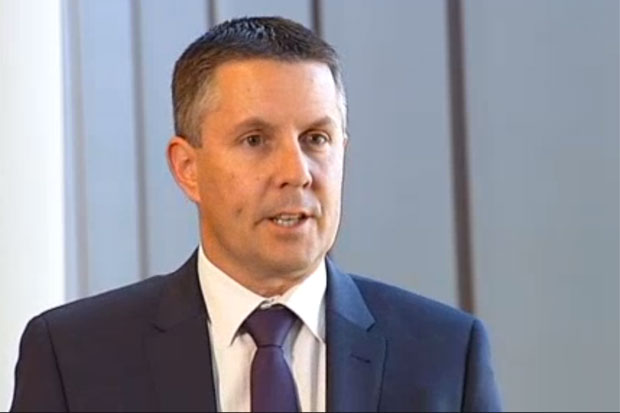The Labor party honed in on environmental policy, and particularly climate action, at its National Conference over the weekend to continue its green branding ahead of the next election.
“Some people think there’s another party that represents environmental protection in this country, but it’s the Labor Party that is the true party of protecting our natural environment,” said Shadow Environment Minister Mark Butler in his address to the party faithful.
The cornerstone of Labor’s green gamble, designed to stem votes bleeding to the Greens, was announced last week when Fairfax reported the party will aim to source 50 per cent of large-scale electricity production from renewable sources by 2030.
“I think the aspiration of 50 per cent renewables by 2030 is a good step,” said Erwin Jackson, Deputy CEO at the Climate Institute.
“Roughly speaking, it’s what you would need for Australia to be playing its fair part in avoiding a two degree rise in global temperatures (which is the internationally agreed threshold for ‘dangerous’ climate change).
“We’ve had too much focus on the short term in climate policy over recent years and it is an opportunity for us to think about where we need to be going in the long term.”
The flip side to that is that the policy is not set in stone and lacks any real detail, but Australian Conservation Foundation climate campaigner Suzanne Harter said Labor’s recent comments are “starting to capture the package” of actions needed to tackle climate change.
“I think right now the broad messaging and the overall commitment is important [although]we will want to see some evidence down the way,” Harter said.
“For example, they have now committed to [announcing]post 2020 pollution reduction targets before the next election… so they are setting themselves up to have to put out some more information relatively soon.
“They’ve also said a few things like ‘we’ll tighten vehicle emission standards’.”
But perhaps the most significant development to emerge over the weekend is that Labor has taken steps to acknowledge that as coal-fired power stations and other fossil fuel reliant workplaces shut down, communities and workers will need to be supported through the clean energy transformation.

“They are saying ‘we are going to establish a comprehensive plan or strategy to deal with this issue’, which we haven’t had before,” Harter said.
“That’s going to require some funding, and [ACF] would point directly at fossil fuel subsidies as one place you might want to look.”
The opposition has put in writing its intention to develop an emissions trading scheme to take to the election, with leader Bill Shorten heading off an almost inevitable line of attack from the Abbott government by reiterating that “an ETS is not a tax”.
The difference is that an emissions trading scheme – which puts a price on carbon and sends a negative price signal across the whole economy – is that it would be a floating price as opposed to the fixed levy which was featured in the Gillard government’s ill-fated carbon tax.
While he believes the conversation around pricing carbon has become “very frustrating”, Johnson said he holds out hope that Labor’s new positioning might help take a bit of the hysteria out of the debate.
“If you’re going to tackle climate change someone has to pay,” he said. “There’s no free lunch, so whether you’re doing it through a tax, an emissions trading system, or a government subsidy fund like the Coalition is [currently]doing, then someone’s paying for it.
“Let’s have a sensible conversation about how we achieve what we need to in the long term.
“Carbon pricing is only part of the approach, and we need to develop a toolbox of approaches.”
Jackson was also encouraged by the fact Labor didn’t announce its new renewables goal would be met through raising the Renewable Energy Target alone.
“To achieve that kind of penetration of renewables into the system, you’re going to have to find a way to modernise the energy system more broadly,” he said.
“They’re saying ‘we’re going to find a variety of mechanisms to ensure that we’re going to be able to deliver this amount of renewable energy’,” Harter said, “and what they’re committing to, I suppose, is finding the set of policies that will deliver an outcome.”
The party also used its National Conference to reaffirm its opposition to the government’s ‘One Stop Shop’ reform, which would effectively unglue decades of environmental law and see the Federal Environment Minister hand back most of his powers to the states and territories.
The policy platform on nuclear energy passed through the conference unchanged, despite what ACF campaigner Dave Sweeney described as “a pretty retrograde push” from elements of the party to “open up opportunities for enrichment, for reprocessing, and disturbingly, for high level international waste storage”.
Earlier this year Jay Weatherill’s South Australian Labor government initiated a Royal Commission into the nuclear fuel cycle, a process seen by many as a way in for a core of Laborites who’d like to see Australia tread the nuclear path in some form, most likely through international waste storage.
Sweeney said that overall developments, or lack thereof, were positive, but the pro-nuclear core “need to be watched, tracked, constrained and reminded that this is a really contested policy area”.
And that’s the real take home message in the environmental policy space from the 2015 ALP National Conference – the signs are promising but the devil is always in the detail, and there are plenty of people watching closely.
Donate To New Matilda
New Matilda is a small, independent media outlet. We survive through reader contributions, and never losing a lawsuit. If you got something from this article, giving something back helps us to continue speaking truth to power. Every little bit counts.




